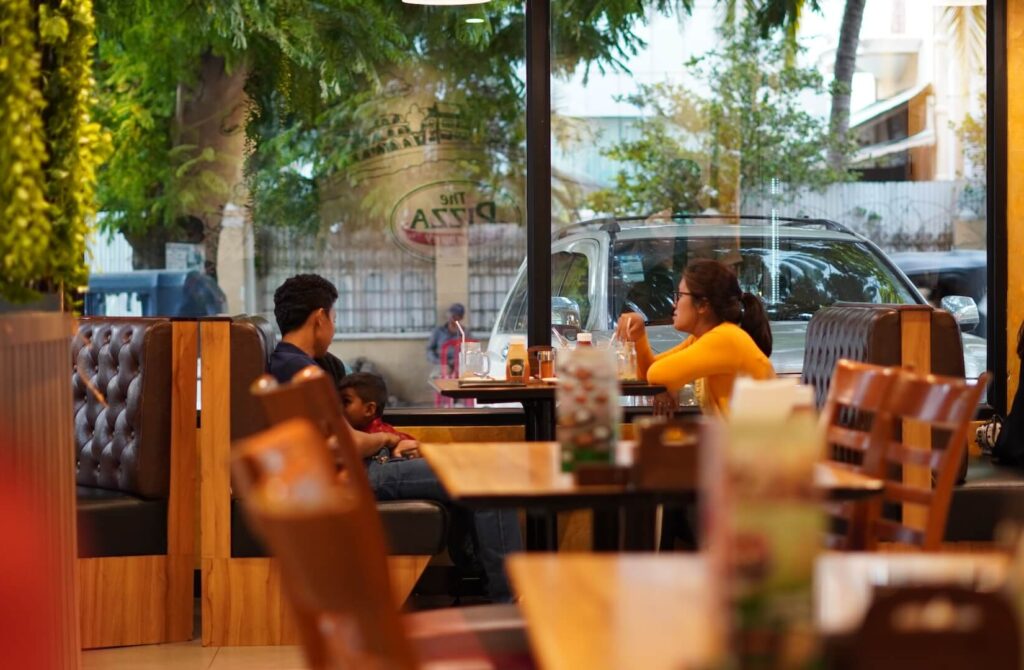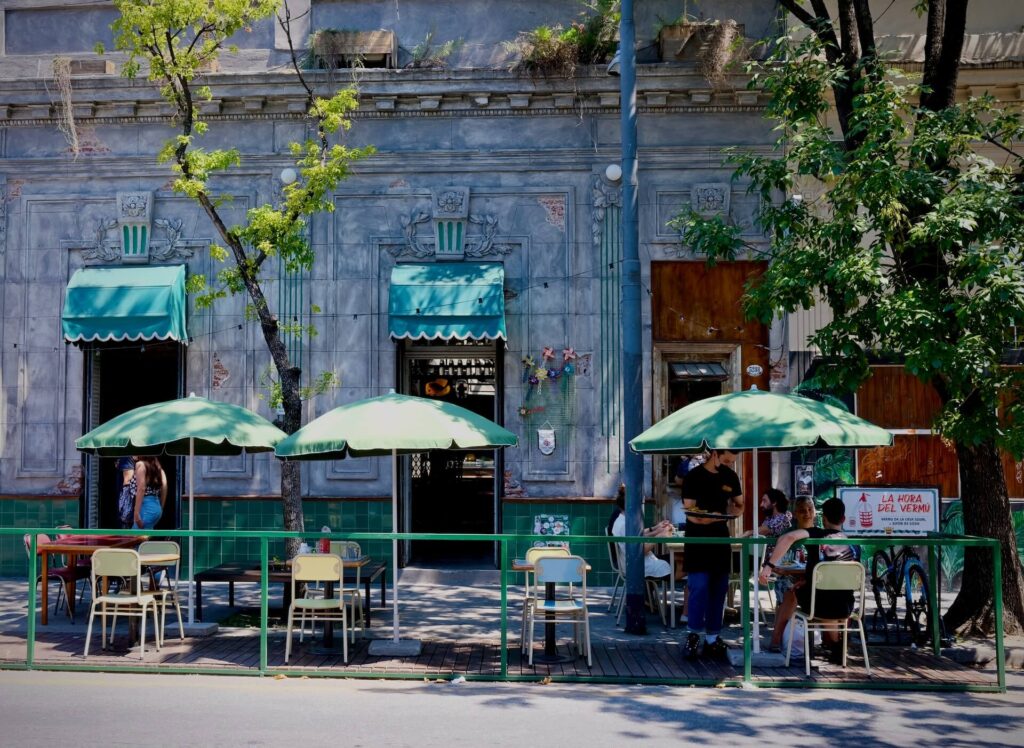Updated on January 28, 2024 by Lou Mac
Learning how to order food in Spanish is perhaps one of the most important things to learn if you’re travelling in a Spanish-speaking country.
And guess what? It’s actually super easy!
You simply state what you want to order.
However, you can embellish it a little more by using phrases like Me gustaría… (I would like…) or Me da… (Can you get me…)
In this post we’ll cover the essential phrases for ordering food in Spanish, plus take you through the ordering process, common words for food and drink, an example scenario and some must try dishes when you’re travelling.

How to Order Food in Spanish
As I mentioned, it’s actually perfectly acceptable to just state your order in Spanish, without any formalities like saying “Can I please have…” etc. as we do in English.
Also remember that this phrase (“Can I please have…”) does not translate in Spanish: when ordering food I used to say Puedo tener… which is the direct translation, but that’s not correct!
But without further adieu, here are the bare essentials for ordering food in Spanish.
- Me da… / me pones… — Can you get me…
- Quisiera… / me gustaría — I would like…
- Voy a tomar… — I’ll drink…
- Para mí… — For me…
- Hola — Hello
- Buen día/buenos días — Good morning, good day
- Buenas tardes — Good afternoon
- Buenas noches — Good evening
- Por favor — Please
- Gracias — Thank you
- Disculpe — Excuse me (to get someone’s attention) / I apologise
- Perdón — Excuse me / I’m sorry
- Con permiso — Excuse me (when passing through)

Ordering Process in Spanish
When you first start ordering food in Spanish, it can feel pretty overwhelming. Native speakers speak quickly, but they will always be happy with your attempts at their language!
Practise these phrases and you’ll be ready for the majority of situations you find yourself in when ordering food.
Enquiring About the Food
- ¿Qué es esto? — What is this?
- ¿Qué lleva este plato? — What ingredients are in this dish?
- ¿Lleva…? / ¿Tiene…? — Does it have…?
- ¿Es picante? — Is this spicy?
- ¿Qué recomienda? — What do you recommend?
- ¿Cuál es el plato del día? — What’s the dish of the day?
- ¿Cuál es su especialidad? — What’s your specialty?
- ¿Cuánto tiempo se tarda en preparar este plato? — How long does it take to prepare this dish?
- Quisiera algo ligero/pesado — I’d like something light/heavy
- Me gustaría probar algo nuevo — I’d like to try something new
Describing Preferences and Dietary Restrictions
- Prefiero… — I prefer…
- No me gusta… — I don’t like…
- Soy vegetariano/a — I’m vegetarian
- Soy vegano/a — I’m vegan
- No puedo comer… — I can’t eat…
- Soy alérgico/a a… — I am allergic to…
- Tengo una intolerancia a… — I have an intolerance to…
- Sin gluten — Gluten-free
- Sin lácteos — Dairy-free
- Sin nueces — Nut-free
- ¿Qué plato es apto para vegetarianos/veganos? — Which dish is suitable for vegetarians/vegans?
- ¿Tienen opciones sin…? — Do you have options without…?
- ¿Hay alimentos sin…? — Are there options without…?
- Carne – meat
- Gluten – gluten
- Lácteos – dairy
- Nueces – nuts
Clarifying Orders
- ¿Puede repetir, por favor? — Can you repeat, please?
- ¿Puede aclarar eso? — Can you clarify that?
- ¿Me puede mostrar en el menú? — Can you show me on the menu?
- ¿Puedo cambiar ___ por ___? — Can I swap ___ for ___?
- ¿Puede hacerlo más picante/menos picante? — Can you make it spicier/less spicy?
- ¿La salsa viene aparte? — Does the sauce come on the side?
- ¿Cómo se prepara este plato? — How is this dish prepared?
- Quería decir… — I meant…
- Lo quería sin… — I wanted it without…
Compliments (and Complaints)
- Me encanta… — I love…
- Me encantó — I loved…
- Está rico — It’s yum/tasty
- Está riquísimo — It’s so yum/tasty
- Está delicioso/a — It’s delicious
- Sabe bien — It tastes good
- Prefiero… — I prefer…
- Hay un problema — There’s a problem
- Falta… — It’s missing/needs…
- No me gusta… — I don’t like…
- Está frío — It’s cold
- Está quemado — It’s burnt
Payment and Bill
- La cuenta, por favor — The check, please
- ¿Cuánto cuesta? — How much is it?
- Incluye la propina — Include the tip
- La propina está incluida —The tip is included
- ¿Hay un cargo por servicio? — Is there a service charge?
- ¿Aceptan tarjetas de crédito? — Do you accept credit cards?
- ¿Puedo pagar en efectivo? — Can I pay in cash?
- ¿Tienen cambio para billetes grandes? — Do you have change for large bills?
- ¿Dónde puedo pagar? — Where can I pay?
- ¿Puedo dividir la cuenta? — Can I split the bill?
Other Requests
- ¿Puede traerme…? — Can you bring me…?
- ¿Podría anotar mi pedido? — Could you take my order?
- ¿A qué hora sirven el desayuno/almuerzo/cena? — What time do you serve breakfast/lunch/dinner?
- Para llevar, por favor — To take away/to go, please
- Sin hielo — Without ice
- Una mesa diferente, por favor — A different table, please

Important Food-Related Vocabulary
There is seemingly endless vocabulary you need to know when ordering food in Spanish.
I don’t want to overwhelm you, so I’ve got the most common words here – but you can also check out this post for a more comprehensive list!
- Desayuno — Breakfast
- Almuerzo — Lunch
- Cena — Dinner
- Entrada — Appetiser
- Plato principal — Main course
- Postre — Dessert
- Bebida — Drink
- Agua — Water
- Cerveza — Beer
- Vino — Wine
- Sopa — Soup
- Ensalada — Salad
- Menú del día — Menu of the day
- Sal — Salt
- Pimienta — Pepper

Numbers and Quantities in Spanish
If you don’t know numbers in Spanish, you might want to start learning them: they’re useful for everything from ordering to paying the bill.
Here are the most common numbers you should know, plus some words for quantities that will definitely come in handy.
- Un poco — A little
- Un poquito — A little (less than un poco)
- Más — More
- Menos — Less
- Unos/as — A few
- Uno/a — One
- Dos — Two
- Tres — Three
- Cuatro — Four
- Cinco — Five
- Seis — Six
- Siete — Seven
- Ocho — Eight
- Nueve — Nine
- Diez — Ten

Example Scenario Ordering Food in Spanish
You can also help prepare yourself by going over potential encounters before they occur.
In the scenario below, you’ll be able to practise making statements as well as understanding and responding to replies!
Ale: Buenas tardes, ¡bienvenida! ¿Qué quieres pedir? (Good afternoon, welcome. What do you want to order?)
Lou: Estoy mirando… ¿Tienen algo sin carne? (I’m looking… Do you have anything without meat?)
Ale: Sí claro, tenemos algunas opciones. ¿Eres vegetariana o vegana? (Yes of course, we have some options. Are you vegetarian or vegan?)
Lou: Soy vegetariana. (I’m vegetarian.)
Ale: Bueno. Estos platos aquí no tienen carne. (Well, these dishes don’t have meat here.)
Lou: ¿Y este plato tiene carne? (And does this dish have meat?)
Ale: Sí, lamentablemente sí. Ese lleva cordero. (Yes, unfortunately yes. It has lamb in it.)
Lou: ¿Y estos? (And these?)
Ale: Mmm, ese lleva pollo y ese lleva vaca. (That one has chicken, and that one has beef.)
Lou: Okay. ¿Cuál es el menú del día? (Okay. What is the menu of the day?)
Ale: Bueno el menú del día tenemos crema de zapallo, para comenzar, y luego tenemos pasta de champiñones, y para postre un flan. (Well, the menu of the day we have pumpkin soup to start, and then we have mushroom pasta and for dessert, a flan.)
Lou: ¡Qué rico! Quiero eso por favor. (Yum! I want that, please.)
Ale: Bueno. ¿Y quieres algo para beber? (Okay. And do you want anything to drink?)
Lou: Sí, ¿un jugo de naranja puede ser? (Yes, an orange juice maybe?)
Ale: Sí claro, vuelvo pronto. ¿Quieres algo más? (Yes of course, I’ll be back soon. Do you want anything else?)
Lou: No, eso nomás. ¡Gracias! (No, just that. Thanks!)

Cultural Insights When Ordering Food in Spanish
- Meal Times: Meal times in many Spanish-speaking countries might be quite different from what you’re used to – this was definitely the case for me! I’ve had situations where the restaurant I wanted to eat dinner at wasn’t even open yet when I arrived 😅
Lunch (often the largest meal of the day) is often eaten between 1:00 PM and 3:00 PM, while dinner is typically served quite late, around 8:00 PM (or even later).
So if you’re going out to eat, be mindful of these cultural norms when planning your evening!
- Tipping Customs: Tipping practices vary across Spanish-speaking countries, so it definitely pays to research the local customs before dining out. In some areas a service charge may already be included in the bill, while in others, it’s customary to leave a tip of around 10% to 15% of the total bill.
While it’s almost expected that you leave a tip in most places, never feel obligated to leave one if you were unhappy with the service or food!
- Be Polite! Maybe this goes without saying, but it’s important to be polite and respectful when ordering food in Spanish (and anywhere, actually!).
Please do not just assume that your waiter/waitress speaks English. Learn some basic, polite greetings and phrases (like the ones in this post) in Spanish and be prepared to use them.
- Spanish Vocabulary. Keep in mind that Spanish vocabulary can change depending on what country you’re in! The basics are usually the same, but sometimes it pays to brush up on a specific dialect before visiting that place. If you’re not sure what kind of Spanish you should learn, check out this post.

Local Dishes to Try by Country
Food is one of the most important things to me when I’m travelling, and if you’re reading this then chances are it’s important to you, too!
Here are a couple of the most common dishes/foods you need to try by country – but remember that this is only brushing the surface!
Chile
I wrote an in-depth post on Chilean food here with dishes that you can’t miss if you’re going to Chile – but the following dishes are a great start.
- Empanadas — These large, savoury pastries are usually filled with ingredients like beef, onions, olives, and hard-boiled eggs
- Pastel de choclo — A (delicious!!) casserole made with ground corn, beef, onions, and spices
- Cazuela — A hearty soup or stew made with meat (often chicken or beef), potatoes, corn, pumpkin, and rice
- Chorrillana — A plate of french fries topped with beef and/or other meats, onions, and fried eggs, often served in local pubs
- Completo — Chile’s take on the hotdog, this street food meal usually consists of a sausage with chopped tomato, smashed avocado and a hearty amount of mayo and ketchup
Argentina
- Asado — While not technically a dish, an Argentine asado is an absolute must if you’re in Argentina (and not a vegetarian/vegan). It’s a barbecue featuring a variety of grilled meats, including big cuts of meat, ribs, sausages and steak, often served with chimichurri sauce
- Empanadas — Different to Chilean empanadas, these are smaller in size, and filled with various things like beef, chicken, ham, tomato and cheese
- Milanesa — Delicious breaded and fried meat cutlet, typically made with beef or chicken
- Matambre a la pizza — Flank steak grilled with a pizza-like topping of tomato sauce, cheese, and herbs
- Facturas — Little pastries filled with different ingredients like quince paste, dulce de leche or custard
Peru
- Ceviche — Fresh fish or seafood marinated in lime juice, mixed with red onions, peppers/capsicum, and coriander
- Lomo saltado — A stir-fry dish featuring beef, onions, tomatoes and french fries, served with rice
- Aji de gallina — Shredded chicken in a creamy yellow chilli sauce, often served with rice and boiled eggs
- Papa a la huancaina — Sliced potatoes topped with a creamy cheese and chilli sauce
Colombia
- Arepas — Cornmeal flatbreads served with various toppings, such as cheese, eggs, or meat
- Bandeja paisa — A traditional platter that typically includes beans, rice, ground beef, chorizo, chicharrón (fried pork belly), avocado, and a fried egg
- Sancocho — A thick soup or stew made with meat (chicken, beef, or fish), potatoes, yuca (cassava), plantains, and corn
- Empanadas — Similar to those in Argentina and other parts of South America, Colombian empanadas are often filled with seasoned ground meat or cheese
- Ajiaco — A creamy chicken soup made with potatoes and a variety of herbs, often topped with capers and cream
Spain
- Paella — This probably needs no introduction, but it’s a rice dish often made with seafood, chicken, rabbit (or a combination of these) and small amounts of vegetables
- Gazpacho — A refreshing cold tomato soup topped with diced jamón serrano
- Tortilla española — A Spanish omelette made with eggs and potatoes, sometimes spiced up with onions and other vegetables
- Jamón serrano — Dry-cured ham, similar to prosciutto (but tastier in my opinion!), served thinly sliced
Remember, even if you’re not confident with your Spanish, just the effort to use it will be positively received by Spanish speakers.
Give it a go and see for yourself!

